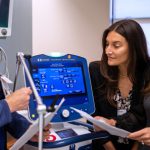A routine part of health care, whether a regular checkup or an emergency, includes examining the body’s vital signs. The heart, lungs and circulatory system can easily be assessed with a stethoscope and a blood pressure cuff.

Dr. Michael McDowell
Monitoring the health of the brain, however, is complicated and requires drawn-out, invasive testing—including placing a probe through the skull for several days—limiting it to critically ill patients who are at risk for serious brain injury. In these cases, measuring intracranial pressure, or ICP, is critical to safeguarding patient recovery. However, it can be risky, Dr. Michael McDowell, assistant professor of neurological surgery at the University of Pittsburgh School of Medicine, noted.
“If untreated, elevated brain pressure can be lethal,” he said. “The problem with invasive testing, other than the fact that it is painful, is that it can be associated with complications, such as infection, damage to the brain and bleeding. Those things are not extremely common, but they are common enough that it limits when we choose to measure brain pressure to circumstances where the risk is justified by the potential benefit.”
The need for a better way to measure ICP inspired McDowell and his collaborator at Carnegie Mellon University, Dr. Jana Kainerstorfer, to create a device that can be worn on the forehead without needing a procedure or incision. Their prototype, a thin black plastic strip that is the size of a business card, gets attached to the patient’s forehead either using a piece of adhesive or a headband. The strip transmits near infrared light and detects the light that bounces off of the brain through the skin and skull. The amount of light that returns to the sensor gives information about the speed of blood flow in the brain. This information, combined with the patient’s heart rate and blood pressure, is used to calculate pressure within the brain in as little as 60 seconds.
In a study recently published in the Journal of Neurosurgery, their team reported on the results of a preliminary study that compared the new ICP measuring device to routine invasive testing.
Fifteen children from the pediatric intensive care unit at UPMC Children’s Hospital of Pittsburgh were included in the trial. The study found that the new device closely matches the more invasive measure, potentially turning a risky procedure into something as minor as listening to a patient’s heartbeat.
“There are a lot of conditions where knowing the brain’s pressure has meaningful benefit, but they are not life-threatening enough to justify measuring ICP invasively. I hope that someday non-invasive ICP will become another vital sign for all patients,” said McDowell.
In the future, the technology could be used to sense changes in patients who have had a concussion, for example, and allow health care providers to make more timely assessments and recommendations to protect their patient’s brain health. For now, McDowell’s plans include replicating this study’s results in adult patients, with the eventual hope that this new device will become mainstream.
Julia O’Brien, Ph.D., R.N., is a postdoctoral scholar at the University of Pittsburgh School of Nursing’s Department of Health and Community Systems. She is participating in the UPMC Science Writing Mentorship Program.









